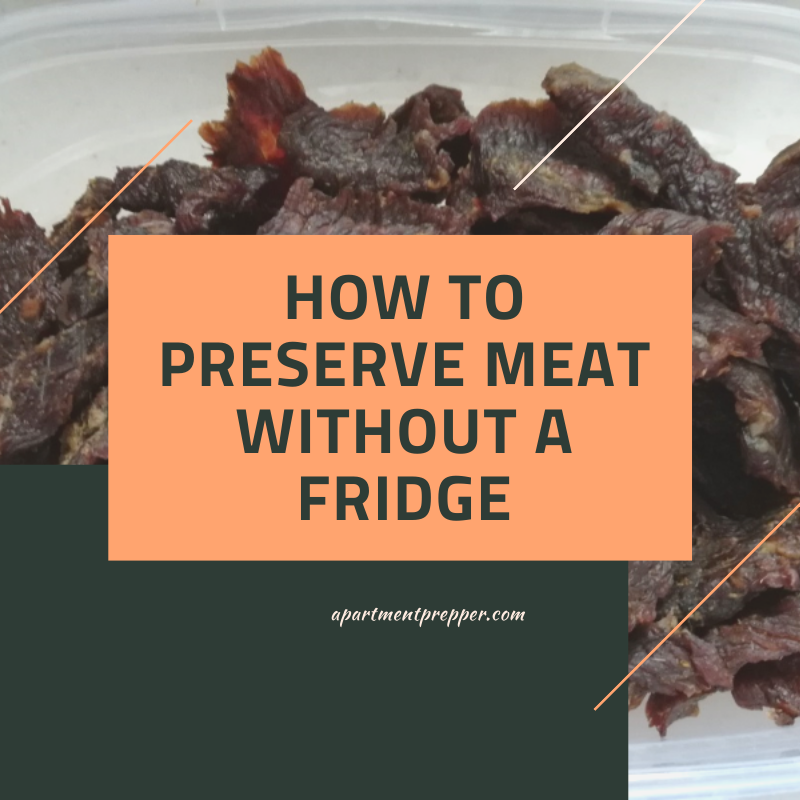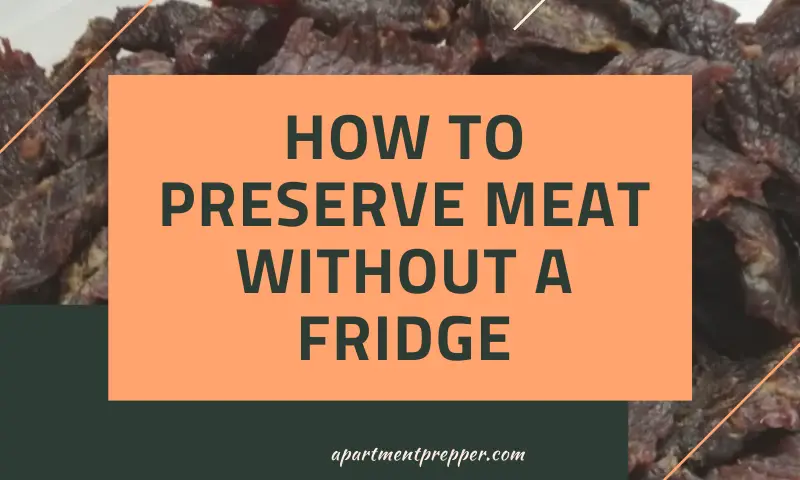Written by Travis Noonan
When a natural disaster strikes, the first thing to go is primary infrastructure – running water, cell towers, internet, and most importantly, electricity. For us apartment dwellers, that usually means no refrigeration. Most outages or disruptive weather events last a few days. But what happens when three days turns into two weeks? A month or longer?
We’ve seen this recently in Puerto Rico: Hurricane Maria left over one million residents without electricity for up to ten months. And the National Infrastructure Advisory Council says the U.S. power grid is at grave risk of suffering catastrophic outages of the same scope. Parts of the mainland U.S could suffer a similar fate in the next hurricane.
That means figuring out how to store your perishable food, sans the first-world conveniences of refrigerators and freezers. Protein matters most, so we’re talking about how to preserve meat without a fridge. You already have most of the “stuff” needed to preserve meat, so let’s take a look at the different methods you can start using right now:
Preserving Meat with Salt
This age-old method of meat preservation dates back thousands of years. It’s perhaps the most cost-effective and proven method of long-term storage without any refrigeration, regardless of climate or temperature. There are few ways to cure your meat with salt. But first, it’s important to note these methods work best when using curing salt, not regular table salt.
Curing salt is pink in color to distinguish it from table salt and to give the cured meat a natural color. It comprises table salt and sodium nitrite. The nitrite works to inhibit the growth of bacteria, specifically clostridium botulinum (botulism). Table salt can be used, but the preservation will not be as effective.
Dry Curing with a Salt Box
Dry curing is the oldest method of preserving meat and works best for pork. You probably eat plenty of dry-cured pork already – prosciutto, pancetta and bresaola are popular dry-cured deli meats. This method is relatively simple and requires no measuring, mixing, or calculations. This method works best in an environment of 50 to 60 degrees, so we recommend curing meat in the colder months.
Instructions
Fill an open, sterile container half-way with curing salt to create a salt box. Use a plastic or glass container, as metal containers may react with the salt mixture. A 1-gallon crock works well. Record the weight of the meat before storage. Place the meat atop the salt and cover it completely with more salt. Roll it around to ensure full coverage. Let the meat rest in the salt box for seven days per inch of thickness.
You’ll know the meat is likely cured by weighing it after letting it rest. The meat should weigh no more than 65% of its original weight. This weight reduction is due to the loss of water and moisture in the meat, stabilizing it and preventing bacterial growth.
Once cured, the meat should remain coated with salt and placed in sterile, air-tight jars or plastic bags. The cured meat can be wrapped in cheesecloth to further draw out moisture.
Preservation: 3 to 4 months (air-tight)
Dry-cured meats will last nearly half a year without refrigeration if sealed in airtight containers or bags. You’ll want to rinse the meat of excess salt before eating and consuming.
Dehydrating Meat – Makin’ Jerky!
Dehydration is another ancient method of storing meat at room temperature. This method works best for fish and red meats like beef, lamb, and venison. This is even easier than salt curing and it requires less processing time to complete.
Instructions
To make your own jerky, it’s recommended you cut your meat into thin slices first – about the width and thickness of traditional pork bacon. The meat should be sterilized by boiling it in water over an open flame or stovetop for three to five minutes. The intention is not to cook the meat.
Next, remove the meat from the water and let it drain until dry. It helps to rest it atop cheesecloth. Next, bake the dry meat in the oven on the lowest temperature setting (around 160-165 degrees F) for 8 to 12 hours. That’s it! You’ve made jerky.
Preservation: 1 to 2 months (air-tight)
The dried and baked meat will last 1 to 2 months in air-tight containers without refrigeration. You may also add salt and other spices and flavors to the meat by coating the strips while they bake in the oven. Dry-rubbing the meat with salts and spices like garlic will also increase the preservation time by several weeks.
Smoking Meat with Wood
Smoking is another method of dehydration and it works for larger cuts of pork, poultry, red meats, and fish. Salt-cured meats can even be smoked after resting and drying, providing preservation up to 4 to 6 months. To smoke meat, all you need is an open flame or smoker and a source of wood. Modern preppers may appreciate by-design gas or charcoal smokers, which include their own instructions and temperature/time requirements.
Recommended woods for smoking meat include:
- Mesquite
- Hickory
- Oak
- Cherry
- Apple
- Maple
- Alder
Instructions
Optionally, salt-cure the meat to be smoked with pink salt first, referencing the dry-curing instructions above. It helps to cut the meat into thin strips to ensure better drying and flavor penetration throughout. Hang the meat above an open flame or smoker with the wood stoked, obtaining an external temperature of 225 to 240 degrees.
The internal temperature of the meat needs to reach 145 degrees for 7 hours, or 155 degrees for 4 hours (165 degrees at 4 hours for poultry). Be careful not to exceed 155 degrees while smoking non-poultry, or the meat will cook instead of cure.
Preservation: 1 to 2 months (air-tight)
Once fully smoked, the cured meat should feel dry, leathery and stiff, and perhaps slightly tacky if flavored or spiced. Storing your smoked meats in air-tight containers will afford 1 to 2 months of preservation at room temperature.
Pressure-Canning Meat
We saved the best (longest-lasting) preservation method for last. Pressure-canning meat is a modern take on room-temperature meat storage and works for beef, venison, or pork. It works more effectively than any other method, too. Importantly, using a traditional boiling-water canning method will not work for storing meat.
Instructions
First, wash the meat and trim it to remove excess fat and gristle. Slice the meat into 1” cubes. You don’t need to cook the meat but you may choose to brown it by boiling. This will sterilize the meat and improve your odds of success. Place the browned (or raw) meat cubes into clean glass canning jars and leave 1” of space under the lid. Add ½ teaspoon of curing salt or table salt to pint jars or 1 teaspoon to quart jars.
Next, boil water in a large pot. Ladle the boiling water over the meat in the jars, leaving 1” of space under the lid. Wipe the rims down and ensure they’re sterile before canning the jars. Lastly, process the jars in a pressure canner:
- Use 10 pounds of pressure at 75 minutes for pint jars
- Use 10 pounds of pressure at 90 minutes for quart jars
- NOTE: If you are 1,000 feet or more above sea level, increase pressure to 15 pounds.
Preservation: One year or more
Properly canned meats will last at least one year before spoiling, even longer if boiled and canned with curing salt. Commercially canned meats can last as long as two to five years. Canned meats are perfect for making savory stews and soups, and they can be dried and cooked on the stovetop or in the oven just as well.
About the author:
Travis Noonan is a Pennsylvanian prepper, military veteran, and gunsmith who writes for Apartment Prepper. He schools other shooters on how to build an AR-15 with an 80 lower receiver. In his spare time, Travis hikes the Appalachian trail and goes bass fishing.



very important canning step for meat that’s always omitted >>> filling the jars leaves grease slobber on the glass jar sealing rim – need to wipe it down with vinegar to guarantee a good seal …
Hi Illini, That is an important tip that would help avoid having unreliable seals. Thanks for the addition! I appreciate the comment.
Using table salt can make the liquid in your canning jars turn cloudy. Doesn’t effect the shelf life or taste.
Hi poorman, Good to know! Thanks for the comment!
That’s right, I think salt is a natural food preservative. good article thanks for sharing
Hey Dan, Glad you like that article. Thanks for the comment.